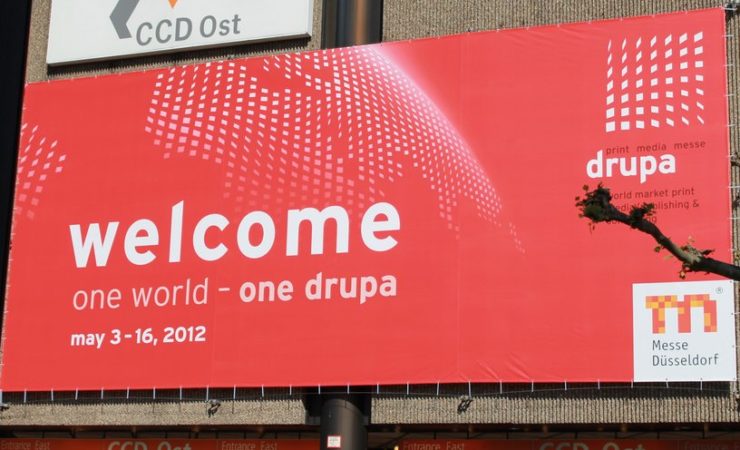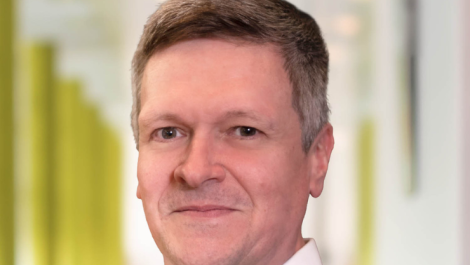The giant Düsseldorf show is all about the numbers, and although visitor numbers were down compared to 2008, the amount of new exciting innovations and technologies shown by the 1850 exhibitors more than made up for the drop. For the label and packaging printer, there was plenty to see as companies fought for a piece of the action in this growth sector. By Neel Madsen.
While the debate is still ongoing as to whether this was another inkjet drupa, the Landa drupa or the workflow drupa or even packaging drupa, there is no doubt that the show was seen by most as a reliable barometer for the state of the printing industry. CEO, Antonio Perez, said at the Kodak press conference, ‘drupa is fundamental to our industry and it will allow us to come out strong from a weak economy,’ and he was not alone in expressing this view. This was an impressive show, and listening to people who have seen a few of these over the years, it was up there among the best. Exhibitors went all out to prove that they are still very much in business, and in fact doing quite well, thank you.
Of course, the fact that Benny Landa was launching his nanotechnology at the show created a buzz that could not be ignored. The use of nano particles in ink seems to be the solution to the limit, which the laws of physics dictate in conventional inkjet, and the presses on the stand looked out of this world, even if they are some way off actually being commercially available. This was quickly followed by the news that UK labels and packaging group, Reflex, was the first in the world to sign on the dotted line of a letter of intent to take a W5 press, which is aimed at cost effective printing of mainstream label and packaging applications. Having previously focused solely on flexo throughout its six UK sites and resisted all other digital offerings, it is perhaps a sign that the tide is changing.
Flexo out in force
But this is not to say that flexo wasn’t out in full force with exciting new press launches and a whole host of new technologies for the packaging printer.
Uteco Group’s new Crystal 808 was running jobs at 500 m/min demonstrated by vice president of marketing and sales, Leonardi Gobbi. Designed for food packing printing, the press was fitted with Rossini’s High Module Carrier and Everstat sleeves. It is also one of the first to utilise the new Rossini Evolution system which makes light work of the CI drum cleaning between jobs. It promises a 15% improvement in output as the order of the size of the plates and sleeves used is no longer relevant.
The first job shown was printed using DuPont Cyrel Fast round sleeves and anilox sleeves from Praxair. It was a six colour job on a white 40 micron PE film using Sun Chemical water-based inks, and demonstrated the latest version of the automatic set up system, Kiss & Go which adjusts the printing decks to achieve the best print quality. The system analyses the printed colour directly on the substrate and needs no registration marks. The operator chooses one colour as a reference and then performs a simple click and drag operation to get all other colours in registration.
Flexotecnica said that it had a record number of press sales at drupa, along with its parent company, Cerutti Group, which also experienced a huge boost in sales of its rotogravure technology.
‘Sales came from all over the world, especially North America, Latin America, the Far East, Middle East, Central and Eastern Europe,’ said Tim Hilton, sales manager, UK and Ireland. The new EVO-XG press, demonstrated on the stand, was sold to an existing customer, Plasticel of Colombia, which already has four presses from the manufacturer.
In addition to the static press demonstration, the company also hosted customers who travelled to Tavazzano, near Milan, to see live printing demonstrations of the latest XG press, equipped with the new auto registration system (ARF). ‘The benefit of this system is that even less waste is generated now, because any reference dot on the image can be selected during set up without having to reset the system. This, combined with our auto impression setting technology (AIF), saves our customers even more money, which is the name of the game today,’ said Mr Hilton.
In total, Cerutti Group signed orders for over 20 machines, with many new projects in the wings to be concluded in the coming months. It said that positive feedback from visitors included comments like, ‘Flexotecnica compares very favourably on a technical level with its global competitors, yet retains the simplicity of operation unmatched by others.’
Easy does it
The new Miraflex CL 10 colour press dominated the Windmöller & Hölscher stand and there were three demos each day. There are almost 200 of this range of presses in operation worldwide today, and Elisabeth Braumann, who is in charge of PR, said that 50% of customers are new and that the market shares in South America, Asia and China, and Eastern Europe are growing. She also said that packaging for beverages is a particular focus for the manufacturer and an application to which the range is well suited.
The press featured all the Easy modules including a new Easy-Set HD option, shown for the first time and aimed at enabling flexo printers to utilise the advantages the new HD plate technology has to offer to the full. Also launched at the show was the latest version of the Turboclean system whichprovides a reduction of energy usage along with an increase in inking and washup efficiency. Energy and solvent usage is reduced by 20% while washup times are reduced to four minutes.
The Institute for Print and Media Technology at Chemnitz University of Technology (pmTUC) showed an interesting example of what the future may bring for flexo printing. It had created a large ‘tree’ with paper leaves onto which solar cells had been printed to illustrate the technology of printed electronics. Under the heading ‘Future of Print’, the topic of printed electronics, such as RFIDs, OLEDs and solar cells, was also debated in the drupa cube.
Ultimate first
Bobst’s new 20SIX press took pride of place on the stand, which I was told, had been a whole year in the planning. The stand followed the trend of being more open and spacious, allowing visitors to drift through, with a central hospitality area as a symbol of how the customer is in focus. Speaking to Eric Pavone, business director BU web-fed, at the beginning of the show, I was told that 20 of this new compact model CI press, which is based on the established FP 16 series, had already been sold. As well as showing its technology, the company also ran a series of seminars around the themes of productivity, innovation and sustainability.
The world’s first 20SIX press is scheduled to be installed in June at Grimsby-based Ultimate Packaging – a company, which is already very familiar with F&K presses. The purchasing decision was preceded by extensive tests at Bobst’s Bielefeld site and these showed that the press was more than able to match the colour values of the company’s digital presses, one of the criteria specified by Ultimate.
‘With its performance and its innovative features, the F&K 20SIX is the ideal answer to the demands encountered in the production of flexible packaging, eg for fresh and frozen foods. It will help us further expand our leading position in this market in the UK,’ said
managing director, Nigel Tonge.
With smartGPS and smartCOL, print jobs can be prepared off the press. While smartGPS sees to registration and printing pressure setting, smartCOL checks the colour before going onto the press, adjusting it and setting the required colour tone. ‘With the F&K 20SIX, we can reduce the makeready times from the previous two hours or so to only about 20 minutes in future. All in all, it offers a substantial increase in productivity,’ explained sales and marketing manager, Chris Tonge.
Sweet spot
Under the heading, ‘The state of the packaging printing industry: global trends, market needs and new technologies’, DuPont Packaging Graphics held its press conference on a boat in Düsseldorf harbour. Matthias Heinzel, global business director, explained the company’s focus on finding its customers’ ‘sweet spot’, which he defined as the intersection between three factors: quality, production and speed, and sustainability. He said, ‘Flexo has improved tremendously and it has now reached a point where it is a solution not just an alternative.’
Global technology manager, Tracy Lunt, who is responsible for new product development and for creating the strategic direction for the next generation flexo print formes, presented the company’s new offerings. ‘We have embarked on an all out effort to develop next generation digital Cyrel plates for both solvent and Cyrel Fast workflows that have resulted in revolutionary improvements to the plate material and the method of plate creation.’
The DSP plate for solvent processing and the DFP for thermal are designed for flexible packaging printers requiring high densities, good minimum dot size and low dot gain. The next generation DFQ is the DFR plate. Predicted to become the workhorse of the Fast range, it is a high durometer digital plate capable of holding the highest screen rulings, fine detail and the widest tonal range, suited to both a standard digital workflow and recently introduced DigiFlow.
In total, 11 new products were launched by DuPont, emphasising the company’s belief, as Mr Heinzel put it ‘that packaging is a very attractive market’. In the last three years, its annual research and development budget has been in the region of $1.6 to 2 billion, which equates to 5% of packaging graphics sales.






